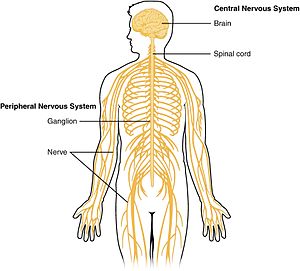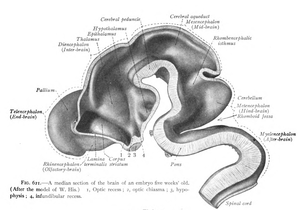Central nervous system
| Central nervous system | |
|---|---|
 Schematic diagram showing the central nervous system in yellow, peripheral in orange | |
| Details | |
| Lymph | 224 |
| Identifiers | |
| Latin | systema nervosum centrale pars centralis systematis nervosi[1] |
| Acronym(s) | CNS |
| MeSH | D002490 |
| TA98 | A14.1.00.001 |
| TA2 | 5364 |
| FMA | 55675 |
| Anatomical terminology | |
The central nervous system (CNS) is the part of the
The rest of this article exclusively discusses the vertebrate central nervous system, which is radically distinct from all other animals.
Overview
In
In vertebrates, the CNS is contained within the
In vertebrates, the CNS also includes the
Structure
The CNS consists of two major structures: the
White and gray matter

Microscopically, there are differences between the neurons and tissue of the CNS and the
The brain (
Spinal cord


From and to the spinal cord are projections of the peripheral nervous system in the form of spinal nerves (sometimes segmental nerves[8]). The nerves connect the spinal cord to skin, joints, muscles etc. and allow for the transmission of efferent motor as well as afferent sensory signals and stimuli.[9] This allows for voluntary and involuntary motions of muscles, as well as the perception of senses. All in all 31 spinal nerves project from the brain stem,[9] some forming plexa as they branch out, such as the brachial plexa, sacral plexa etc.[8] Each spinal nerve will carry both sensory and motor signals, but the nerves synapse at different regions of the spinal cord, either from the periphery to sensory relay neurons that relay the information to the CNS or from the CNS to motor neurons, which relay the information out.[9]
The spinal cord relays information up to the brain through spinal tracts through the final common pathway[9] to the thalamus and ultimately to the cortex.
-
Schematic image showing the locations of a few tracts of the spinal cord.
-
Reflexes may also occur without engaging more than one neuron of the CNS as in the below example of a short reflex.
Cranial nerves
Apart from the spinal cord, there are also peripheral nerves of the PNS that synapse through intermediaries or
Two pairs of cranial nerves; the olfactory nerves and the optic nerves[4] are often considered structures of the CNS. This is because they do not synapse first on peripheral ganglia, but directly on CNS neurons. The olfactory epithelium is significant in that it consists of CNS tissue expressed in direct contact to the environment, allowing for administration of certain pharmaceuticals and drugs. [7]
Brain
At the anterior end of the spinal cord lies the brain.[9] The brain makes up the largest portion of the CNS. It is often the main structure referred to when speaking of the nervous system in general. The brain is the major functional unit of the CNS. While the spinal cord has certain processing ability such as that of spinal locomotion and can process reflexes, the brain is the major processing unit of the nervous system.[12][13]
Brainstem
The brainstem consists of the medulla, the pons and the midbrain. The medulla can be referred to as an extension of the spinal cord, which both have similar organization and functional properties.[9] The tracts passing from the spinal cord to the brain pass through here.[9]
Regulatory functions of the medulla nuclei include control of blood pressure and breathing. Other nuclei are involved in balance, taste, hearing, and control of muscles of the face and neck.[9]
The next structure rostral to the medulla is the pons, which lies on the ventral anterior side of the brainstem. Nuclei in the pons include pontine nuclei which work with the cerebellum and transmit information between the cerebellum and the cerebral cortex.[9] In the dorsal posterior pons lie nuclei that are involved in the functions of breathing, sleep, and taste.[9]
The midbrain, or mesencephalon, is situated above and rostral to the pons. It includes nuclei linking distinct parts of the motor system, including the cerebellum, the basal ganglia and both cerebral hemispheres, among others. Additionally, parts of the visual and auditory systems are located in the midbrain, including control of automatic eye movements.[9]
The brainstem at large provides entry and exit to the brain for a number of pathways for motor and autonomic control of the face and neck through cranial nerves,
The brainstem also holds the reticular formation, a group of nuclei involved in both arousal and alertness.[9]
Cerebellum
The cerebellum lies behind the pons. The cerebellum is composed of several dividing fissures and lobes. Its function includes the control of posture and the coordination of movements of parts of the body, including the eyes and head, as well as the limbs. Further, it is involved in motion that has been learned and perfected through practice, and it will adapt to new learned movements.[9] Despite its previous classification as a motor structure, the cerebellum also displays connections to areas of the cerebral cortex involved in language and
The body of the cerebellum holds more neurons than any other structure of the brain, including that of the larger
Diencephalon
The two structures of the diencephalon worth noting are the thalamus and the hypothalamus. The thalamus acts as a linkage between incoming pathways from the peripheral nervous system as well as the optical nerve (though it does not receive input from the olfactory nerve) to the cerebral hemispheres. Previously it was considered only a "relay station", but it is engaged in the sorting of information that will reach cerebral hemispheres (neocortex).[9]
Apart from its function of sorting information from the periphery, the thalamus also connects the cerebellum and basal ganglia with the cerebrum. In common with the aforementioned reticular system the thalamus is involved in wakefullness and consciousness, such as though the SCN.[9]
The hypothalamus engages in functions of a number of primitive emotions or feelings such as hunger, thirst and maternal bonding. This is regulated partly through control of secretion of hormones from the pituitary gland. Additionally the hypothalamus plays a role in motivation and many other behaviors of the individual.[9]
Cerebrum
The cerebrum of cerebral hemispheres make up the largest visual portion of the human brain. Various structures combine to form the cerebral hemispheres, among others: the cortex, basal ganglia, amygdala and hippocampus. The hemispheres together control a large portion of the functions of the human brain such as emotion, memory, perception and motor functions. Apart from this the cerebral hemispheres stand for the cognitive capabilities of the brain.[9]
Connecting each of the hemispheres is the corpus callosum as well as several additional commissures.[9] One of the most important parts of the cerebral hemispheres is the cortex, made up of gray matter covering the surface of the brain. Functionally, the cerebral cortex is involved in planning and carrying out of everyday tasks.[9]
The hippocampus is involved in storage of memories, the amygdala plays a role in perception and communication of emotion, while the basal ganglia play a major role in the coordination of voluntary movement.[9]
Difference from the peripheral nervous system

This differentiates the CNS from the PNS, which consists of neurons, axons, and
The way in which the Schwann cells and oligodendrocytes myelinate nerves differ. A Schwann cell usually myelinates a single axon, completely surrounding it. Sometimes, they may myelinate many axons, especially when in areas of short axons.[8] Oligodendrocytes usually myelinate several axons. They do this by sending out thin projections of their cell membrane, which envelop and enclose the axon.
Development
During early development of the vertebrate embryo, a longitudinal
The
As a vertebrate grows, these vesicles differentiate further still. The telencephalon differentiates into, among other things, the
-
Development of the neural tube
| CNS | Brain | Prosencephalon |
Telencephalon |
Rhinencephalon, amygdala, hippocampus, neocortex, basal ganglia, lateral ventricles | |
| Diencephalon |
Epithalamus, thalamus, hypothalamus, subthalamus, pituitary gland, pineal gland, third ventricle | ||||
Brain stem |
Mesencephalon |
Tectum ,
cerebral peduncle,
pretectum ,
mesencephalic duct
| |||
Rhombencephalon |
Metencephalon | ||||
| Myelencephalon | Medulla oblongata | ||||
| Spinal cord | |||||
Evolution
Planaria
A molecular study found that more than 95% of the 116 genes involved in the nervous system of planarians, which includes genes related to the CNS, also exist in humans.[18]
Arthropoda
In
Chordata
The CNS of
Mammals
Clinical significance
Diseases
There are many CNS diseases and conditions, including
References
- ^ Farlex Partner Medical Dictionary, Farlex 2012.
- ^ ISBN 0-13-981176-1.
- ISBN 978-3-642-64619-5.
- ^ ISBN 9780878937424. Archivedfrom the original on 11 March 2014.
- ^ "Medical Subject Headings (MeSH): Optic Nerve". National Library of Medicine. Archived from the original on 2 October 2013. Retrieved 28 September 2013.
- ^ ISBN 978-0-7020-3738-2.)
{{cite book}}: CS1 maint: multiple names: authors list (link - ^ PMID 22788696.
- ^ ISBN 978-1-60547-652-0.)
{{cite book}}: CS1 maint: multiple names: authors list (link - ^ ISBN 978-0-07-139011-8.
- ^ ISBN 978-3-540-34686-9.)
{{cite book}}: CS1 maint: multiple names: authors list (link - PMC 7158194.
- )
- ^ "The brain and spinal cord – Canadian Cancer Society". www.cancer.ca. Retrieved 19 March 2019.
- ISBN 978-0878939787.
- PMID 19763105.
- ISBN 978-0-07-297004-3.
- ISBN 978-0-8053-6844-4.
- PMID 12802012.
- PMID 24965579.
- ^ Romer, A.S. (1949): The Vertebrate Body. W.B. Saunders, Philadelphia. (2nd ed. 1955; 3rd ed. 1962; 4th ed. 1970)
- ^ ISBN 978-0-7817-6003-4.
- ^ Feinberg, T. E., & Mallatt, J. (2013). The evolutionary and genetic origins of consciousness in the Cambrian Period over 500 million years ago. Frontiers in psychology, 4, 667. https://doi.org/10.3389/fpsyg.2013.00667
- ISBN 0-07-303869-5.
- ^ American College of Radiology; American Society of Neuroradiology (2010). "ACR-ASNR practice guideline for the performance of computed tomography (CT) of the brain". Agency for Healthcare Research and Quality. Reston, VA, US: American College of Radiology. Archived from the original on 15 September 2012. Retrieved 9 September 2012.
External links
- Overview of the Central Nervous System at the Wayback Machine (archived 2012-02-18)
- High-Resolution Cytoarchitectural Primate Brain Atlases
- Explaining the human nervous system.
- The Department of Neuroscience at Wikiversity
- Central nervous system histology











